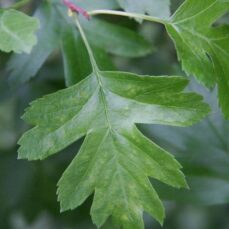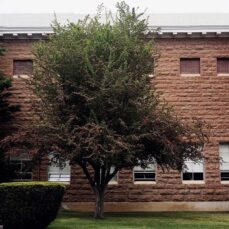English Hawthorn (Crataegus monogyna)

Photo credit: Tom DeGomez, University of Arizona, Bugwood.org
Squamish
Whistler
Pemberton
Vectors of Spread
Synonyms
Common hawthorn, single-seed hawthorn, one-seed hawthorn
ID Characteristics
General: Small, thorny, deciduous tree or shrub in the Rose family.
Flowers: Small white, sometimes pink flowers are grouped in umbrella-like clusters of 10-20. The flowers resemble cherry or apple blossoms. Each flower has 5 – 25 stamens with pink-purple anthers that extend past the petals, and one style.
Stem: Mature plants are 2 – 9 m tall. The stems usually branch from a single trunk. The bark is smooth, pale, and grey; new shoots are reddish. English hawthorn branches are covered with long thorns.
Leaves: Deeply cleft leaves with 3 – 7 lobes. The leaves resemble mittens and have a leathery texture. They are typically 2 – 5 cm long.
Fruit: One-seeded round fruits are bright to deep red. The fruits only develop on mature plants (10 years or older), and last on the plant late into winter.
Roots: Taproot.
Similar Species
Black hawthorn (or Douglas’ hawthorn, Crataegus douglasii) has weakly lobed leaves, flowers with five styles instead of one, and blackish fruits.

Black Hawthorn Dave Powell, USDA Forest Service (retired), Bugwood.org

Black Hawthorn Dave Powell, USDA Forest Service (retired), Bugwood.org
Habitat and Origin
English hawthorn is native to West Asia, Europe, and Northern Africa, where it was used to create hedgerows to contain livestock. It was introduced in the 1800s to Oregon and southern Washington, where it began spreading across North America.
English hawthorn grows in lowland areas in many soil types but grows best in moist soil or areas with high precipitation. Mature plants are drought and somewhat shade-tolerant. English hawthorn is found in woodlands, pastures, riparian areas, grasslands, and meadows. It thrives best in deeper soils.
Impacts
Ecological:
- Reduces biodiversity.
- Forms thorny thickets that block animal movement.
- Could hybridize with native black hawthorn, which may outcompete and decrease native populations and create a weedier, more competitive variety.
- Birds may prefer English hawthorn berries to those of native black hawthorn, causing a reduction in the regeneration of native plants.
Economic:
- Nuisance species in pastures and grazing areas.
How it Spreads
English hawthorn reproduces both by seed and vegetatively. Each tree can produce 2,000 berries, and the seeds germinate in spring. English hawthorn can also regenerate from cuttings. An individual plant can live up to 250 years, giving it ample opportunity to spread.
English hawthorn can spread locally by vegetative reproduction through cuttings, but long-distance dispersal occurs through the transport of seeds. The fruits are highly favourable to birds that consume and transport them great distances. They are primarily dispersed by the American Robin but can also be spread by other animals.
Prevent the Spread
English hawthorn is NOT currently found in the Sea to Sky Corridor, so the best approach to controlling its spread is by PREVENTION.
This is a high-priority invasive species for the Province of BC, and it is included in the Early Detection and Rapid Response (EDRR) program.
If you see English hawthorn, please report it.
Distribution of English Hawthorn in BC
English Hawthorn Factsheet
Having trouble viewing the factsheet? Don’t worry, all the information is included on this page. You can also contact us with any questions.
References
- CABI Invasive Species Compendium, English Hawthorn
- City of Nanaimo, Controlling Invasive Plants
- Fraser Valley Invasive Species Society, English Hawthorn
- Garry Oak Ecosystems Recovery Team, Invasive Species in Garry Oak and Associated Ecosystems in BC
- King County Noxious Weed, English Hawthorn
- Washington State Noxious Weed Control Board, English Hawthorn
- WeedWise Clackamas SWCD, English Hawthorn














